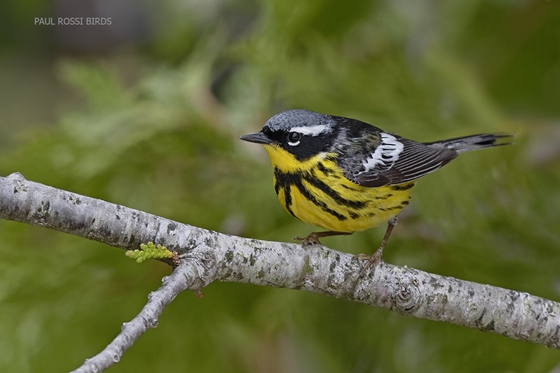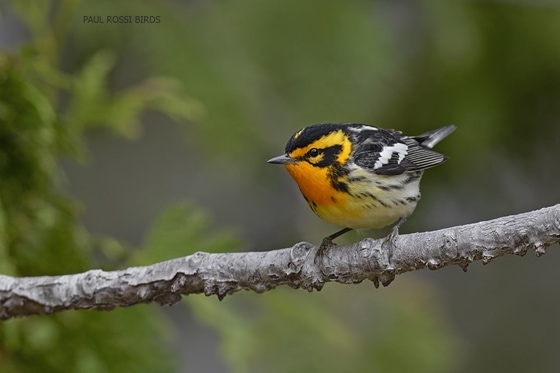Waves of Warblers
By Marjorie Powell
My husband Joe and I spent 5 days in May visiting friends who have retired to the north shore of Lake Huron, a last-minute trip planned because of a family birthday party in Illinois – once you plan to fly to Chicago, it makes sense to expand the trip to see friends in Michigan. Mary and I went to college together and we’ve kept in touch over the years. Her husband Keith is a fly-fishing enthusiast, but also enjoys watching birds wherever they travel or live. I gave no thought to the time of year, but knew that Keith enjoyed both local and migrating birds, and had a friend, Paul Rossi, who specialized in photographing the birds, especially the warblers, that breed in or migrate through Michigan’s Upper Peninsula. As a treat for me, Keith had arranged a morning trip with Paul. Keith and Mary had given me a copy of his coffee-table book, Beautiful Birds of Michigan’s Eastern Upper Peninsula, so I had seen his stunning pictures of many of the birds that spend time in this part of Michigan.

The first morning of our visit, we watched Common Mergansers swim and feed in the waters in front of their house and hummingbirds feed, rest, and feed again as soon as Keith filled the feeder. We also walked up their driveway searching for the birds we could hear in the trees. Keith identified a few of the birds by their calls, a feat which always intrigues me, because my hearing and memory for sounds are not as well developed. Some year I will gather my courage and sign up for Denise White’s “Birding by Ear” class.
I was looking forward to the morning trip as it had rained each of the first few days we were there. Friday morning was wet and overcast, but no rain as we set out. While Paul is the expert photographer, I took my camera in the hope that I might get a few pictures, although with warblers I was not optimistic – I’m much better with larger shorebirds that stand still.

During the early weeks of migration, Paul uses a speaker to play bird calls to attract migrants; the trees were full of birds hiding, resting after their flight across Lake Huron, and feeding in preparation for their travel further north to breeding locations. Paul selects which bird calls to play by identifying a bird that he can hear calling, or drawing on his knowledge that a particular species usually stops at a specific location at this time of year. Paul often said things like “Pine Warblers like this spot” or “I’ve seen Ovenbirds here in the past few days” as we stopped to listen at various spots within a 5 mile radius of Keith and Mary’s house.
Our first stop was just outside the house, to listen to calls and locate a male American Redstart. We then moved a few steps to the grass above the septic tank, to focus on a pine tree just at the west end. One warbler and then another, sometimes three or four warblers flew to the tree, to the ground in front of the tree, and into a deciduous tree next to the pine. Paul called out their names, Keith and I looked, Keith occasionally pointed to a bird half-hidden that I’d not yet spotted, and the birds flitted away. I focused on trying to find the birds and raise my binoculars to get a better look, ignoring my camera for most of the time. Sometimes I just focused on finding the bird before it skittered to a new location. Among the warblers we saw there were Black-and-white Warbler, Black-throated Green Warbler, Yellow-rumped Warbler and Chestnut-sided Warbler.

We moved further out the driveway and spotted more warblers – male and female American Redstart, Blackburnian Warbler, Northern Parula. Along with many unfocused pictures as birds or I moved, I managed to get a couple of reasonable pictures, including both male and female American Redstarts and a Blackburnian Warbler.

We piled into two cars – Paul’s was too full of equipment, including cameras, to hold two more people, and slowly drove the single lane road off the peninsula, stopping occasionally to listen for birds. At one narrow causeway we saw Tree Swallows perched on top of nesting boxes. On the main road, we headed east to an old dirt logging road, parked and walked up the road, looking for birds. Several warblers called and a couple came closer to check out the noise, but some birds Paul expected had apparently not yet made the trip across Lake Huron.

After walking back to the road, we slowly drove west, past marshes, where we stopped to look for but did not see the Mute Swan (Keith and I had seen it earlier in the week). We got a glimpse of a Sandhill Crane on the lawn of the local motel on our way to our next stop, We listened again for elusive warblers, instead spotting another Sandhill Crane walking along the clearing under power lines. Throughout the morning we heard, and sometimes saw, other birds, such as Red-wing Blackbirds. On to the John Arthur Woollam Preserve, where we parked and walked, listening and looking. There we saw an Ovenbird and a Pine Warbler, which I managed to photograph because it sat at the end of a branch for a minute or so.

When we reviewed the list of birds we’d seen, I realized that at least two of them were new life birds for me; now I have to study them so I can identify them if I’m in their territory and they stay still long enough. After the trip, as I deleted the many pictures of moving but bare branches, I discovered a few pictures clear enough for me to identify the birds, including American Redstart and Pine Warbler. I’ll have to rely on pictures on Paul’s website for most of the warblers that we saw that fast-moving morning.
Paul’s Facebook page with some stunning pictures is at www.facebook.com/beautifulbirdseup/ and his bird photo website can be found at paulrossibirds.wordpress.com/.
Marjorie retired and moved from the Chesapeake Bay to the San Francisco Bay a few years ago. In addition to trying to learn about west coast birds through GGBA classes and field trips, she is a member of GGBA’ Friends of the Alameda Wildlife Reserve and travels frequently with her husband.
EDITOR’S NOTE: If you are interested in seeing Eastern Warblers for yourself, GGBA is offering Ohio: Eastern Warblers & Spring Migration Sensation May 8-15, 2020. Check out our travel page for more info. You can also view the full itinerary HERE.
